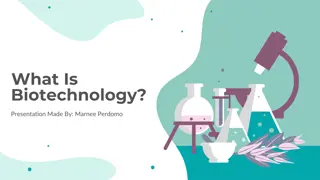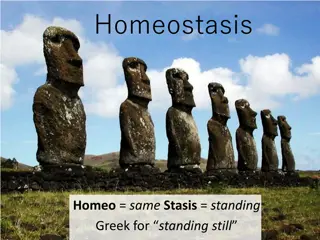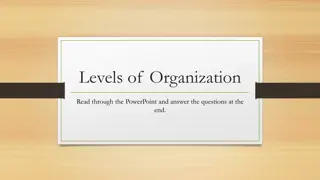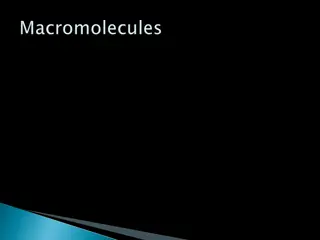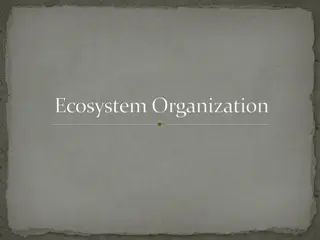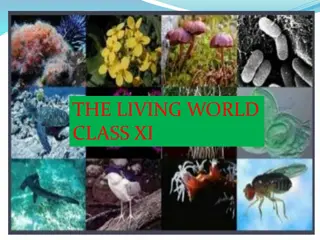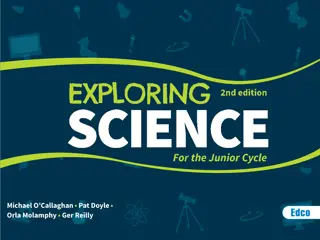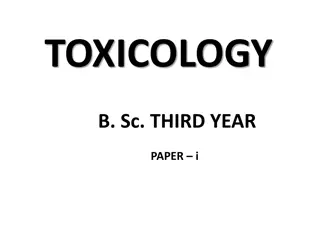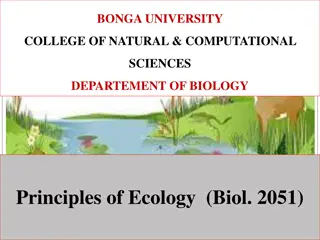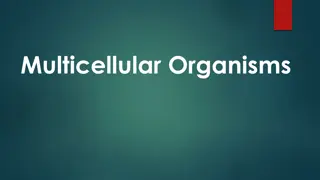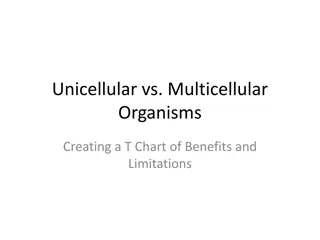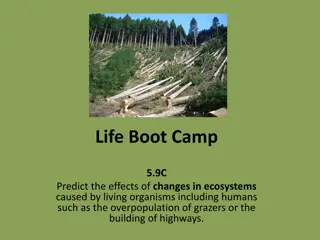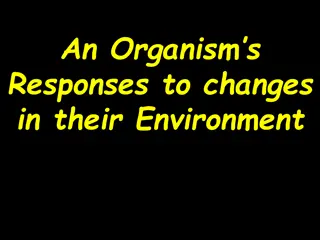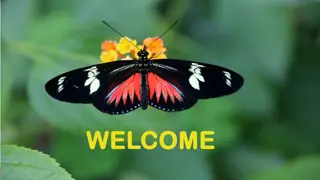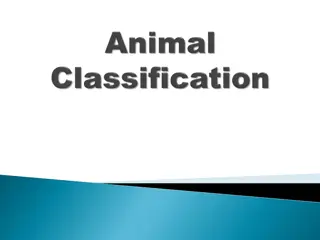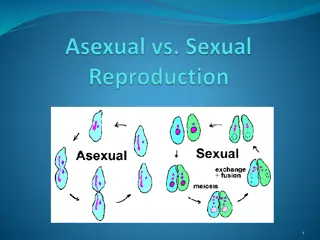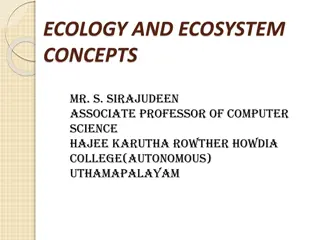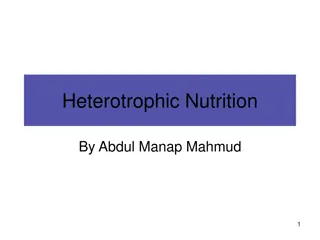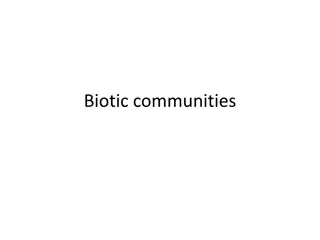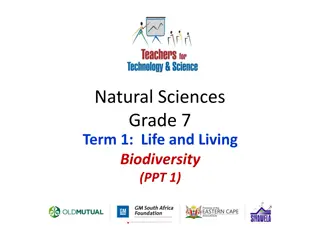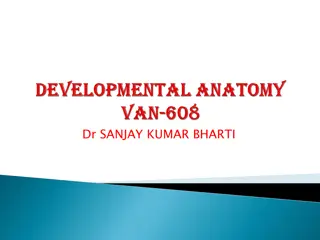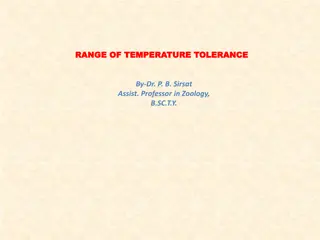Understanding Ecology: Interactions Between Organisms and their Environment
Ecology is the scientific study of how living organisms interact with each other and their environment. It delves into the relationships between biotic and abiotic factors, encompassing topics such as the distribution and abundance of organisms, structural adaptations, behavior under natural conditi
2 views • 42 slides
Understanding Ecosystems: Ecological Interactions and Dependencies
Ecology is the study of how organisms interact with their environment, influencing their distribution and abundance. This exploration covers terrestrial and aquatic biomes, energy flow, environmental impacts, adaptations, and global ecosystems, emphasizing the interconnectedness of all living organi
2 views • 58 slides
Understanding Biotechnology: A Comprehensive Overview
Biotechnology is the application of technology based on biology, utilizing living organisms and molecular biology to create healthcare products. It involves studying the functionality of living organisms by combining biology, physics, chemistry, mathematics, and technology. Careers in biotechnology
0 views • 8 slides
Understanding Homeostasis in Living Organisms
Homeostasis, derived from Greek meaning "standing still", is crucial for maintaining balance in living organisms. It involves regulating internal variables to prevent disease or death. Ancient Greeks emphasized the importance of harmony and equilibrium in life. Claude Bernard and Walter B. Cannon fu
1 views • 29 slides
Understanding Levels of Organization in Living Organisms
Explore the levels of organization in living organisms, from atoms to cells, and the differences between unicellular and multicellular organisms. Learn about prokaryotes, eukaryotes, cell differentiation, chromosomes, and the importance of stem cells in development and repair.
0 views • 17 slides
Understanding Carbohydrates in Living Organisms
Carbohydrates, along with proteins, lipids, and nucleic acids, are essential macromolecules in living organisms. They are made up of carbon, hydrogen, and oxygen in a 1:2:1 ratio. Carbohydrates provide the main energy source for living things, with examples including glucose, fructose, and sucrose.
0 views • 58 slides
Adaptations for Efficient Material Exchange in Organisms
Understanding how cells and organisms adapt for effective material exchange through diffusion, surface area to volume ratio, and specialized exchange surfaces. Larger organisms require specialized structures for efficient exchanges, in contrast to smaller organisms that can rely on simple diffusion.
0 views • 19 slides
Understanding Ecosystem Organization and Hierarchy
Explore the intricate relationships within ecosystems through the study of organization and hierarchy. From individual organisms to complex communities, learn how biotic and abiotic factors shape these environments. Gain insights into the levels of ecosystem organization, from single organisms to in
5 views • 15 slides
Understanding the Characteristics of Living Organisms
Life is a unique biochemical process expressed through chemical reactions leading to growth, development, responsiveness, adaptation, and reproduction. Living organisms exhibit characteristics such as growth, definite shape and size, reproduction, metabolism, and cellular organization. These traits
4 views • 32 slides
Understanding the Characteristics of Living Things
Living things, known as organisms, exhibit essential characteristics including being made of cells, requiring nutrition, excreting wastes, responding to changes in their surroundings, and reproducing. They are classified into different groups such as bacteria, fungi, plants, animals, and others like
2 views • 33 slides
Introduction to Toxicology: Science and Impact on Living Organisms
Toxicology is the study of adverse effects of chemicals on living organisms. It assesses probability of occurrence, quantitatively and qualitatively analyzing toxic effects. Toxicants are agents causing harmful responses in biological systems. Environmental toxicology focuses on pollutants' effects
0 views • 12 slides
Fundamentals of Taxonomy Explained: From Classification to Nomenclature
Taxonomy, derived from Greek roots, encompasses the science of classifying organisms and understanding their variations, evolutionary relationships, and naming conventions. It involves description, identification, classification, and nomenclature of both living and extinct organisms. The practices o
1 views • 39 slides
Understanding Biosynthetic Pathways in Living Organisms
Biosynthesis, also known as anabolism, involves the formation of complex organic compounds from simple subunits catalyzed by enzymes within living organisms. This process is vital for the development of life and the production of essential compounds like carbohydrates, proteins, vitamins, antibiotic
1 views • 21 slides
Principles of Ecology: Understanding Organism-Environment Interactions
Ecology is the scientific study of how living organisms interact with each other and their environment. It involves understanding organisms at their native habitats, from individuals to ecosystems. The discipline encompasses various branches and focuses on the relationships shaping the distribution
1 views • 14 slides
Understanding Acquired Traits and Learned Behaviors in Living Organisms
Acquired traits are physical characteristics acquired during a living thing's lifetime, such as scars, and are not passed down from parents. Many acquired traits are also learned behaviors, like reading or flying, which animals develop after birth. Learned behaviors, unlike inherited instincts, are
5 views • 15 slides
Exploring Multicellular Organisms: Structures and Functions
Learn about multicellular organisms, including examples like humans, animals, and plants, and how their cells, tissues, organs, and systems work together to perform various functions. Understand the difference between single-celled and multicellular organisms and why some require specialized cells t
0 views • 15 slides
Reproduction in Organisms: Overview and Types
Understanding the concept of reproduction in organisms, this content delves into the different modes of reproduction such as asexual and sexual, with examples and illustrations. It covers the life spans of various organisms and details various methods of asexual reproduction like fission, budding, s
0 views • 23 slides
Unicellular vs. Multicellular Organisms: A Comparative Analysis
Unicellular and multicellular organisms differ in structure, division of labor, specialization, exposure to environment, response to injury, size limitations, lifespan, and ability to divide. Unicellular organisms have a single-cell body, limited operational efficiency, and face challenges in size a
0 views • 12 slides
Understanding Ecosystem Dynamics: The Food Web Explained
An ecosystem comprises various organisms living together in a community. Energy flow through food chains depicts how organisms obtain energy and nutrients from one another. Food chains show the sequence of feeding relationships, while a food web illustrates interconnected chains within a community.
1 views • 13 slides
Understanding Ecosystem Changes Caused by Living Organisms
Explore the effects of changes in ecosystems caused by living organisms, including humans, such as the overpopulation of grazers or the introduction of invasive species like kudzu. Learn how these factors impact native plants, water supply, weather patterns, and the balance of organisms within ecosy
0 views • 97 slides
Understanding Relationships Between Organisms in Nature
Explore the various relationships between organisms in nature, including intraspecific and interspecific interactions such as competition, predation, and parasitism. Learn how organisms compete for resources, hunt and protect themselves, as well as how parasites survive on host organisms. Delve into
2 views • 13 slides
Organisms' Responses to Environmental Changes
Organisms demonstrate responses to changes in their environment through stimuli and reactions. These responses can be internal or external, leading to behaviors such as seeking food, avoiding danger, or adjusting growth patterns. Examples include animals seeking food when hungry or plants growing to
3 views • 15 slides
Understanding Unicellular and Multicellular Organisms in Biology
Explore the basic differences between unicellular and multicellular organisms, including the distinctions between prokaryotes and eukaryotes. Unicellular organisms, such as bacteria and amoeba, consist of a single cell and are often microscopic. Examples of both prokaryotic and eukaryotic unicellula
0 views • 10 slides
Understanding Taxonomy and Classification in Biology
Scientists use classification to group organisms logically, making it easier to study life's diversity. Taxonomy assigns universally accepted names to organisms using binomial nomenclature. Carolus Linnaeus developed this system, organizing organisms into species, genus, family, order, class, phylum
0 views • 11 slides
Exploring the Fascinating World of Living Beings: Classification, Characteristics, and Beyond
Delve into the intriguing realm of living beings with Assistant Teacher Amina Afroze at Foundation School. Explore the classification of organisms into different superkingdoms, kingdoms, and species. Learn about the diverse characteristics of organisms such as monera, protista, fungi, plantea, and a
0 views • 14 slides
Understanding the Classification of Living Organisms
Living organisms are classified into five kingdoms, each further divided into smaller groups called phyla, classes, orders, and genus. The five kingdoms are Monera, Fungi, Protista, Plantae, and Animalia. Animals are categorized into invertebrates and vertebrates, with significant agricultural impor
0 views • 50 slides
Understanding Bioelements in Living Organisms
Bioelements are chemical elements crucial for the molecules in living organisms. They include major elements like oxygen, carbon, hydrogen, and trace elements such as iron, zinc. These elements play essential roles in maintaining growth, development, and health across different organisms. Understand
0 views • 9 slides
Understanding the Characteristics of Living Things
Explore the key characteristics of living things, including the need for materials, energy, and living space, as well as the organizational structure, growth, reproduction, and ability to respond to the environment. Dive into topics such as the Cell Theory, spontaneous generation theories by scienti
0 views • 12 slides
Understanding Organic Chemistry and Macromolecules
Organic chemistry focuses on compounds with carbon bonds, while inorganic chemistry deals with other compounds. Carbon is unique due to its ability to form multiple bonds, creating diverse structures like chains and rings. Organic compounds, produced by living organisms, range from simple to complex
0 views • 32 slides
Understanding Asexual Reproduction in Living Organisms
Explore the fascinating world of asexual reproduction in living organisms through informative images and descriptions covering various forms such as binary fission, budding, fragmentation, and regeneration. Learn how asexual reproduction differs from sexual reproduction and discover examples of orga
0 views • 15 slides
Understanding Ecology: Key Concepts and Types Explained
Ecology, a vital branch of science, delves into the relationships between organisms and their environment. It encompasses biotic and abiotic factors, studying how living and non-living elements interact within ecosystems. Biotic components include living organisms like plants and animals, while abio
0 views • 7 slides
Understanding Cellular Respiration and Fermentation Processes
Cellular respiration is the energy-releasing process in which organisms take in glucose and oxygen to produce carbon dioxide, water, and energy. This process is vital for all living organisms. Photosynthesis and respiration are opposite processes, with respiration requiring the products of photosynt
0 views • 10 slides
Understanding the Characteristics of Living Organisms
This content covers the basic principles and characteristics of life, including organization, response to stimuli, homeostasis, metabolism, growth and development, reproduction, and evolution. It also explains the levels of organization in living organisms, the aspects of cell theory, and why viruse
0 views • 54 slides
Ecology and Ecosystem Concepts: Understanding Interrelationships in Nature
Ecology explores the interconnections between living organisms and their environment, dating back to zoologist Geoffroy St. Hilaire's early proposal in 1859. The term "ecology" originates from the Greek words for house and discourse, emphasizing the study of organisms within their habitat. Ecosystem
0 views • 36 slides
Understanding Heterotrophic Nutrition in Organisms
Heterotrophic nutrition refers to the process where organisms, such as animals, rely on preformed organic molecules from their environment or other organisms for nutrients and energy. These organisms are unable to produce organic compounds from inorganic sources and must obtain nourishment from exte
0 views • 55 slides
Exploring Living and Non-living Things: Unit 1 Activities
Dive into the concept of living and non-living things with engaging activities such as learning about examples of living things, going on a living things hunt, and watching educational videos. Get hands-on by observing, drawing, and sharing your findings to deepen your understanding in an interactiv
1 views • 4 slides
Understanding Biotic Communities and Benthic Ecosystems
Living organisms in an area form biotic communities categorized into producers, consumers, omnivores, detrivores, and decomposers. Aquatic organisms such as plankton, benthos, and nekton play vital roles. Benthic communities refer to organisms attached to or burrowing in aquatic ecosystems, influenc
0 views • 17 slides
Understanding Biodiversity and Classification of Living Organisms
Explore the world of biodiversity and the classification of living organisms in Grade 7 Natural Sciences - Term 1. Learn about the five main kingdoms, Carl Linnaeus' taxonomy work, and the seven-level classification system he introduced. Discover how organisms are grouped and categorized to better s
0 views • 17 slides
Understanding Gametogenesis and Spermatogenesis in Living Organisms
Gametogenesis is a vital process in living organisms where germ cells develop into gametes for reproduction. Spermatogenesis, specifically in males, involves phases like multiplication, growth, and maturation to produce sperm. This intricate process ensures the perpetuation of species through the fo
0 views • 49 slides
Temperature Tolerance of Organisms in the Universe
Life on Earth exists within a range of temperatures, with organisms displaying varied temperature tolerance. Eurythermal organisms can withstand large temperature fluctuations, while stenothermal organisms tolerate only small variations. The temperature range for each species is crucial for their ph
0 views • 8 slides


